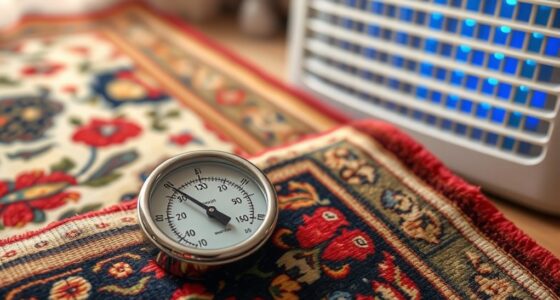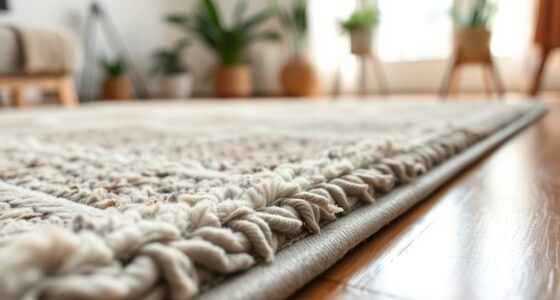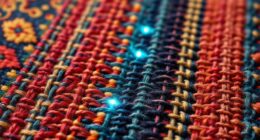Temperature swings can weaken silk fibers by causing repeated expansion and contraction, which damages its molecular bonds over time. These fluctuations lead to micro-damage, cracks, and a reduction in tensile strength, making silk more brittle and prone to breakage. Handling and storing silk carefully in stable environments helps preserve its durability. If you want to understand how to protect silk from temperature-related damage and improve its longevity, there’s more to explore.
Key Takeaways
- Repeated temperature swings cause micro-damage and microcracks in silk fibers, weakening tensile strength over time.
- Heat exposure temporarily increases fiber flexibility but risks elasticity loss, reducing overall tensile resilience.
- Cold temperatures induce fiber contraction and brittleness, increasing the likelihood of breakage and tensile failure.
- Thermal expansion and contraction during temperature cycles induce internal stresses, diminishing silk’s structural integrity.
- Proper environmental control and heat-resistant coatings can mitigate tensile strength loss caused by temperature fluctuations.
How Temperature Fluctuations Impact Silk Fibers
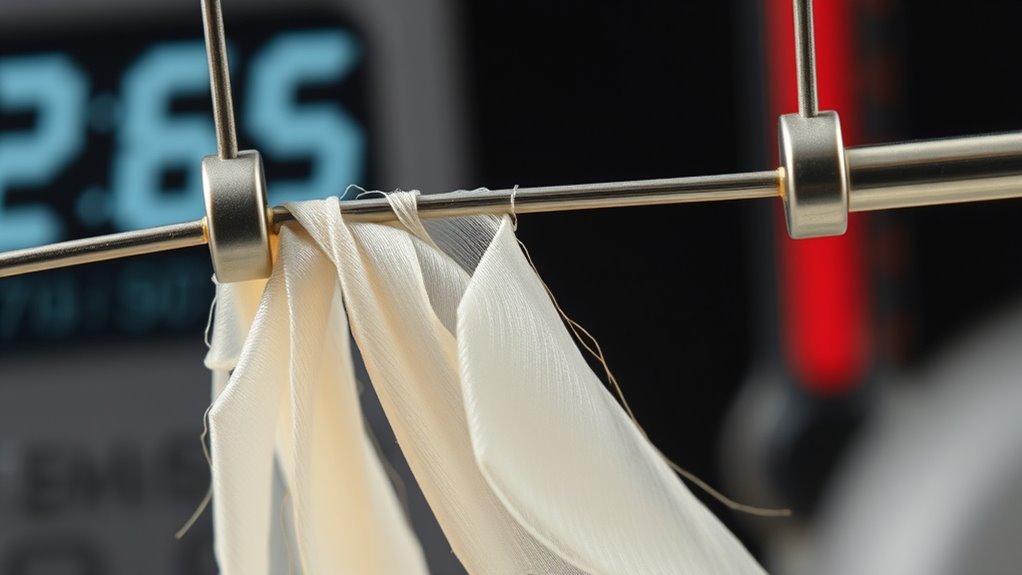
Temperature fluctuations can markedly affect silk fibers by causing them to expand and contract. During silk cultivation, inconsistent temperatures can weaken the fibers, reducing tensile strength and making them more prone to damage. When exposed to heat, silk fibers may become more flexible temporarily but risk losing elasticity over time. Cold temperatures can make silk brittle, increasing the likelihood of breakage. These changes also influence dye compatibility; abrupt temperature shifts can cause uneven dye absorption, resulting in inconsistent coloration. Maintaining stable temperatures during silk production helps preserve fiber integrity and ensures better dye adherence. Additionally, understanding the properties of silk fibers can guide better handling and processing techniques. As you handle or process silk, understanding how temperature swings impact its properties allows you to optimize conditions for stronger, more durable silk with vibrant, uniform colors.
The Science Behind Silk’s Response to Heat and Cold
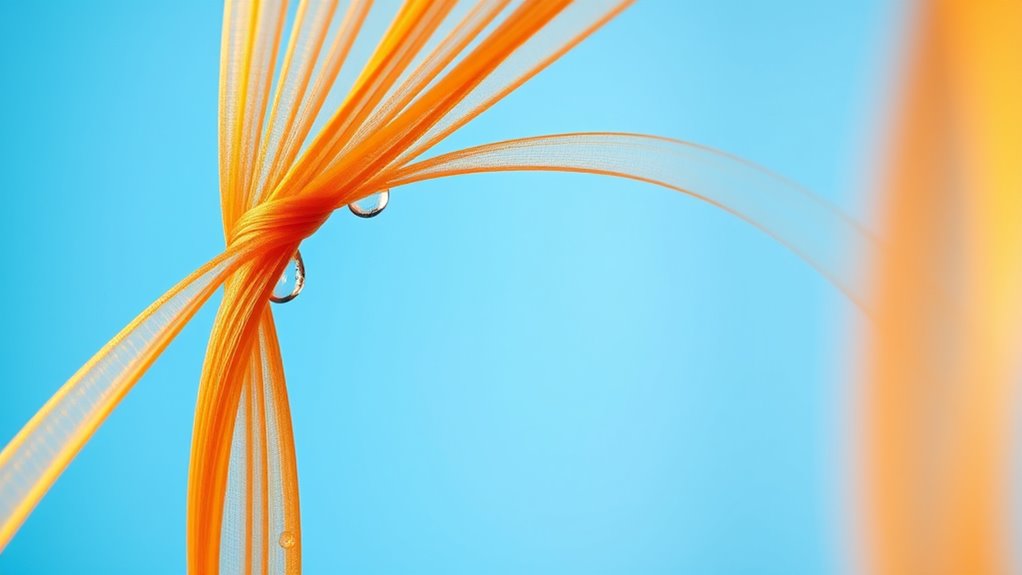
Silk’s response to heat and cold stems from its unique molecular structure, primarily composed of fibroin proteins arranged in a highly ordered crystalline and amorphous pattern. When exposed to heat, the crystalline regions can slightly expand, affecting silk’s flexibility and appearance during silk dyeing processes. Cold temperatures cause the fibers to contract, impacting how the silk weaves and holds shape. This molecular behavior explains why silk is sensitive to temperature changes during manufacturing and finishing. In silk weaving, temperature fluctuations can influence the tension and drape of the fabric, while in silk dyeing, heat can alter how dyes penetrate and bond with the fibers. Advances in material science help us better understand and optimize these temperature-dependent behaviors, allowing for improved control over silk’s qualities during production. Understanding these molecular responses helps you optimize processes to preserve silk’s strength and aesthetic qualities under varying temperature conditions.
Effects of Repeated Heating and Cooling Cycles on Tensile Strength
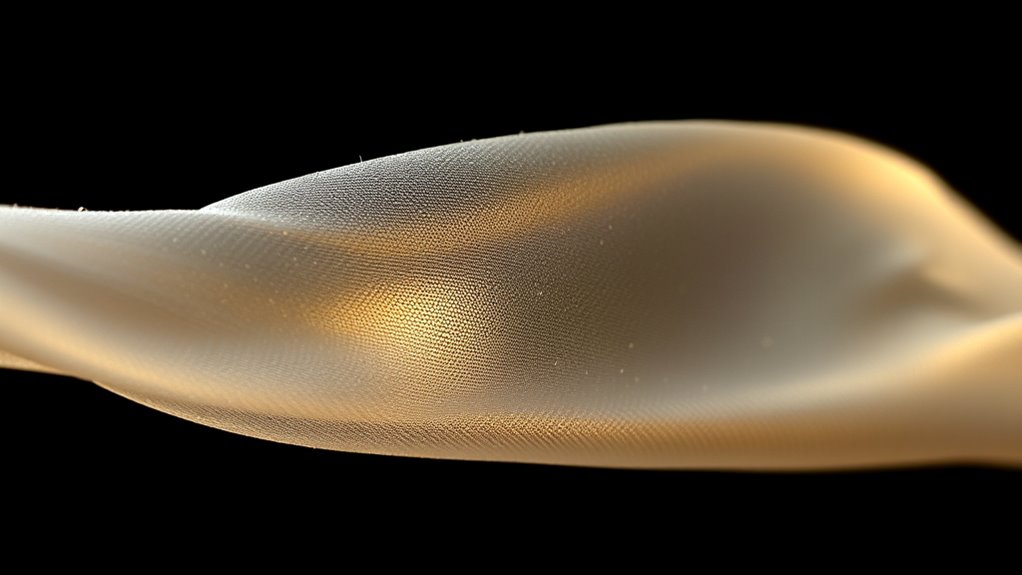
Repeated heating and cooling can cause material fatigue in silk, weakening its fibers over time. As the fibers expand and contract, thermal stresses build up, leading to micro-damage. Understanding these effects helps you predict how silk’s tensile strength changes with continuous temperature fluctuations. Incorporating expert voice actors in presentations can further clarify these complex processes for better audience comprehension.
Material Fatigue Development
When silk fabrics undergo frequent heating and cooling cycles, their structural integrity can weaken over time. This process accelerates fiber aging, where repeated stress causes microscopic damage within the silk’s protein structure. Fatigue mechanisms play a vital role here, as each thermal cycle induces tiny cracks and disruptions in the fibers. Over time, these accumulated damages reduce tensile strength and elasticity, making the fabric more prone to tearing. The repeated expansion and contraction weaken intermolecular bonds, leading to progressive deterioration. Unlike sudden failures, fatigue develops gradually, often unnoticed until significant damage has occurred. Understanding these fatigue mechanisms helps explain why silk’s tensile strength diminishes with continuous temperature swings, emphasizing the importance of controlling thermal exposure during handling and use.
Thermal Expansion Effects
As silk fibers experience cycles of heating and cooling, they undergo physical changes that directly impact their strength. Repeated thermal expansion and contraction cause microscopic damage, weakening the fiber’s internal structure. Silk’s thermal conductivity influences how quickly it responds to temperature changes, affecting its ability to withstand stress. When exposed to fluctuating temperatures, silk’s thermal insulation properties can either protect it or accelerate degradation, depending on the environment. Over time, these thermal expansion effects lead to microcracks and fiber fatigue, reducing tensile strength. Understanding how thermal conductivity and insulation interact during temperature swings helps in predicting silk’s durability. Proper material selection and environmental control are crucial for maintaining silk’s tensile properties and ensuring its longevity in various applications.
Temperature-Related Changes in Silk’s Structural Integrity
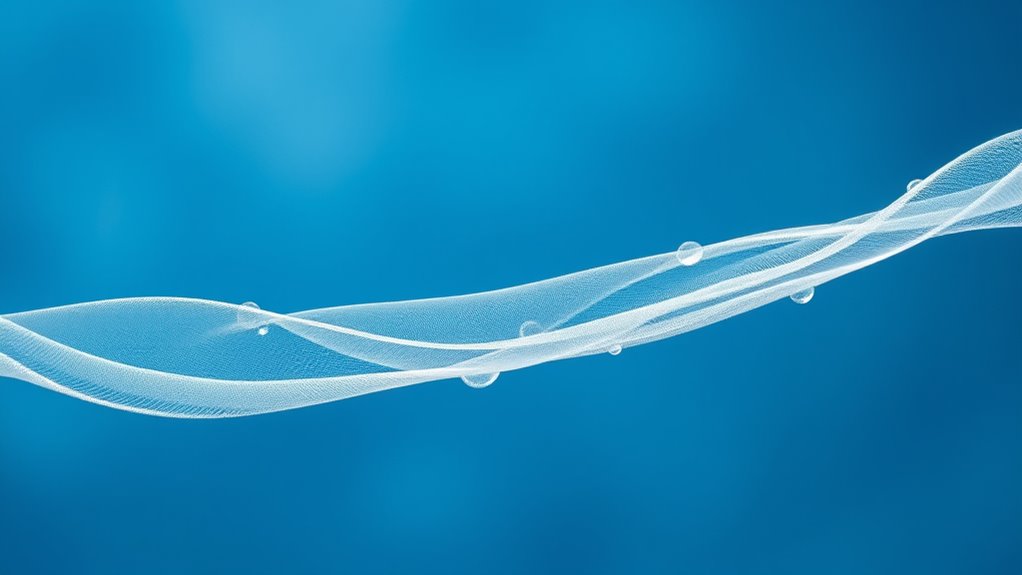
Temperature fluctuations can considerably impact silk’s structural integrity by altering its molecular bonds and crystalline regions. When exposed to heat or cold, silk fibers can weaken, becoming more prone to damage. During silk dyeing, high temperatures may cause dye molecules to penetrate unevenly, affecting the fabric’s overall strength. Similarly, in silk weaving techniques, temperature changes can influence fiber flexibility and cohesion, leading to potential tears or distortions. Repeated thermal stress may disrupt the orderly crystalline structure that gives silk its tensile strength, making it more susceptible to breakage. Additionally, understanding the effects of temperature on silk’s molecular bonds helps in developing better preservation techniques. Understanding these temperature-related effects is essential for maintaining silk’s durability. Properly controlling temperature during processes like dyeing and weaving helps preserve the fiber’s molecular integrity and ensures the final product retains its desired strength and longevity.
Best Practices for Handling and Storing Silk in Varying Climates

Handling and storing silk properly across different climates requires attention to environmental conditions that can affect its delicate fibers. Maintain a stable, cool environment to prevent damage during silk dyeing or weaving. Keep silk away from direct sunlight, humidity, and temperature fluctuations. Use breathable storage containers and acid-free tissue to prevent deterioration. For example, consider the following:
| Climate Condition | Best Practice | Result |
|---|---|---|
| Hot & Humid | Store in climate-controlled space | Prevent mold and fiber weakening |
| Cold & Dry | Use breathable covers | Avoid brittleness |
| Temperature Swings | Maintain consistent environment | Preserve tensile strength |
| Handling Silk During Dyeing | Keep at steady temperature | Achieve even dye absorption |
Adhering to these practices ensures your silk remains strong for weaving projects and vibrant in dyeing. Proper climate control plays a crucial role in maintaining silk’s integrity over time.
Innovations in Silk Treatment to Enhance Durability
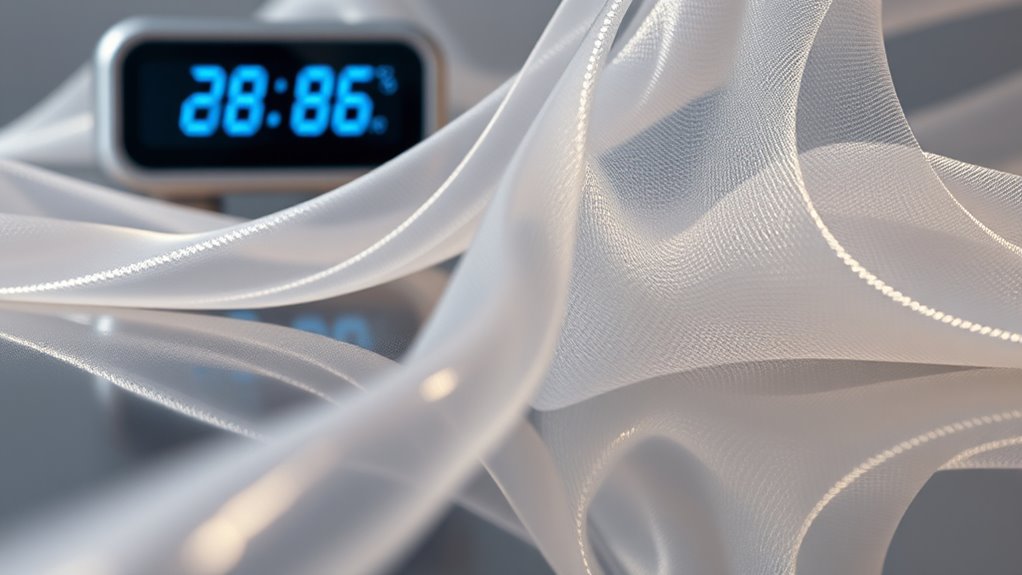
Innovations like heat-resistant silk coatings and temperature-stable fiber treatments are transforming silk’s durability. These advancements help silk withstand temperature swings without losing strength or flexibility. By adopting enhanced tensile testing techniques, researchers are ensuring these treatments deliver consistent, reliable performance. Additionally, understanding the thermal properties of silk is crucial for optimizing these innovations.
Heat-Resistant Silk Coatings
Recent advancements in silk treatment focus on developing heat-resistant coatings that substantially improve durability under high-temperature conditions. These coatings protect silk during processes like silk dyeing and silk weaving, where heat exposure can weaken fibers. By applying innovative chemical formulas, manufacturers create a barrier that resists thermal damage and maintains tensile strength. This allows silk to withstand extreme temperatures without losing flexibility or strength. Additionally, these coatings help preserve the color fidelity of silk fabrics when exposed to heat. You’ll notice:
- Improved resilience during dyeing processes involving high heat
- Enhanced longevity of silk fabrics in hot environments
- Reduced fiber degradation from temperature fluctuations
- Better overall performance in demanding applications
These coatings open new possibilities for silk’s use in industrial settings, ensuring it remains durable and beautiful even under intense heat.
Temperature-Stable Fiber Treatments
As silk industries seek to extend the fiber’s durability under extreme conditions, researchers are developing temperature-stable treatments that enhance silk’s resilience without compromising its natural properties. These innovations improve fiber weaving by making silk more resistant to temperature fluctuations, reducing the risk of fiber weakening or breakage. Additionally, temperature-stable treatments help maintain ideal dye absorption, ensuring vivid, long-lasting colors even after exposure to heat. By applying specialized coatings or cross-linking agents, manufacturers can enhance silk’s thermal stability without altering its softness or breathability. This allows you to produce textiles better suited for outdoor or high-temperature environments. Moreover, these advancements align with sustainable practices by potentially reducing the need for frequent re-dyeing or replacement, thus contributing to eco-friendly production. Ultimately, these treatments boost silk’s durability, opening new possibilities for functional, aesthetically appealing fabrics that withstand temperature swings without losing their integrity.
Enhanced Tensile Testing Techniques
Enhanced tensile testing techniques have become essential for accurately evaluating silk’s durability after treatment modifications. These innovations allow you to better assess properties like fiber elasticity and dye stability, which determine silk’s performance under temperature swings. By using dynamic testing methods, you can simulate real-world conditions more effectively, revealing how treatments affect tensile strength over time. Additionally, incorporating automation in testing can improve measurement precision and repeatability, leading to more reliable results. Consider these advancements:
- Automated load and strain measurement for precise results
- Micro-scale testing to analyze fiber elasticity at the microscopic level
- Thermal cycling protocols to evaluate dye stability during temperature fluctuations
- Real-time data analysis for quick feedback on treatment effects
With these techniques, you gain deeper insight into how silk treatment impacts durability, ensuring your fabrics perform well even under challenging environmental conditions.
Practical Tips for Maintaining Silk’s Strength Over Time

To keep silk strong over time, proper handling and maintenance are essential. When engaging in silk dyeing, avoid harsh chemicals or prolonged exposure to direct sunlight, as these can weaken fibers. During silk weaving, handle the fabric gently to prevent stress and tearing. Wash silk using mild detergents and cold water to preserve its tensile strength; avoid machine washing when possible. Store silk in a cool, dry place, away from temperature swings that can cause fibers to expand and contract, weakening over time. When not in use, keep silk garments wrapped in breathable fabric to prevent damage. Regularly inspecting your silk items allows you to catch and address any signs of wear early, ensuring the fabric retains its strength and beauty for years to come.
Frequently Asked Questions
How Does Humidity Influence Silk’s Tensile Strength During Temperature Fluctuations?
Humidity impact plays a significant role in silk’s tensile variability. When humidity levels rise, silk fibers absorb moisture, making them more flexible and less prone to breaking. Conversely, low humidity causes silk to dry out and become brittle, reducing tensile strength. During temperature fluctuations, these humidity changes can amplify tensile variability, so maintaining consistent humidity helps preserve silk’s strength and durability in varying environmental conditions.
Can Temperature Swings Cause Irreversible Damage to Silk Fibers?
Temperature swings can cause irreversible damage to silk fibers through thermal fatigue, which weakens the fiber structure over time. As silk repeatedly experiences rapid changes in temperature, it undergoes expansion and contraction, leading to fiber degradation. This process compromises silk’s tensile strength, making it more prone to breakage and reducing its lifespan. To preserve silk’s integrity, avoid exposing it to extreme or fluctuating temperatures that accelerate these damaging effects.
Are There Specific Silk Varieties More Resistant to Thermal Stress?
Like the armor of a knight, some silk varieties show greater resilience against thermal stress. You’ll find that thermal resistant silks, such as Tussah or Eri, possess higher Silk varietal resilience, making them more resistant to temperature swings. These silks maintain their tensile strength better under thermal fluctuations. If you’re seeking durable silk options, choose these varieties for their enhanced ability to withstand heat and cold without damage.
How Does Prolonged Exposure to High Temperatures Affect Silk’S Elasticity?
When you expose silk to high temperatures for a prolonged period, thermal degradation occurs, which can weaken the fiber’s structure. This process reduces silk’s elasticity, making it less flexible and more prone to breakage. As the fibers lose their elastic properties, they become brittle and less durable. To preserve silk’s elasticity, avoid sustained high heat exposure, and store it in cool, dry environments.
What Are the Long-Term Effects of Temperature Cycling on Silk Preservation?
Oh, the glamorous world of silk preservation—you’re in for a treat! Temperature cycling causes thermal fatigue, leading to structural degradation over time. This relentless dance of heating and cooling weakens silk’s fibers, making it more fragile and prone to tears. Long-term, your delicate silk might just surrender to these invisible battles, losing its luster and strength. So, if you cherish silk, keep it cool and steady—avoid the drama of thermal fatigue!
Conclusion
Did you know that silk can lose up to 20% of its tensile strength after just 10 thermal cycles? By understanding how temperature swings affect silk fibers, you can better care for your delicate fabrics. Proper storage and handling in fluctuating climates are key to maintaining durability. With innovative treatments, silk’s resilience continues to improve. Keep these tips in mind to preserve your silk’s beauty and strength for years to come.


